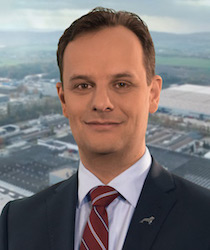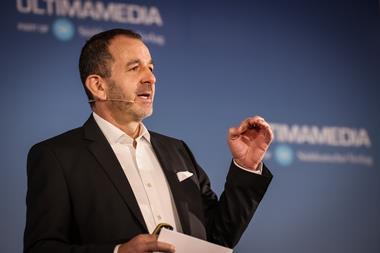The company's manager at its 1.1m sq.m Salzgitter parts plant discusses the €30m transformation that will double non-driven axle output to 900 per day; a new assembly line combines MAN and Scania production GP: How did the idea for the project originate?TR: It started when we built up a new cooperation within the Volkswagen Group’s truck and bus division. The question was asked: ‘what would be the ideal shape of our production network?’. The guys at Scania know their business, and we know our business. Our focus is on NDAs; we have a great history, we’ve produced them here for more than 30 years. We were able to make a business case to concentrate NDA production for both brands here at Salzgitter. Meanwhile, Scania is making gearboxes for MAN production at Munich and Krakow. Each focuses on their strengths and we have two winners.
GP: How did the idea for the project originate?TR: It started when we built up a new cooperation within the Volkswagen Group’s truck and bus division. The question was asked: ‘what would be the ideal shape of our production network?’. The guys at Scania know their business, and we know our business. Our focus is on NDAs; we have a great history, we’ve produced them here for more than 30 years. We were able to make a business case to concentrate NDA production for both brands here at Salzgitter. Meanwhile, Scania is making gearboxes for MAN production at Munich and Krakow. Each focuses on their strengths and we have two winners.
GP: How is the cooperation progressing?TR: We’ve already built 7,500 NDAs on this line for MAN. For the Scania NDAs, we are running approval tests and our ramp-up will come at the beginning of 2018. By the end of next year, Salzgitter will have produced all NDAs for MAN and Scania for the European network, with the driven axles continuing to be built by MAN in Munich and by Scania at Södertälje, Sweden.
I’m really grateful for the cooperation with colleagues in Södertälje; for more than a year, we have had regular interchange between the plant management teams. Every three to four months, we meet just to learn from each other. It’s given us an extremely strong understanding and makes me confident for the ramp-up.
GP: What were the most pleasing aspects of the project?TR: Completely new production lines. It’s not a refresh or a copy – it’s an innovation. We took a white piece of paper and came up with new methods of working, a comfortable working environment, lots of light; a state-of-the-art production line for 2018.

"We took a white piece of paper and came up with new methods of working, a comfortable working environment, lots of light; a state-of-the-art production line for 2018"– Thomas Rennemann, MAN
We are working to decrease takt time from four minutes to 54 seconds. This is a huge step in our production thinking. One question we had to answer was almost philosophical: ‘do we build one line or two?’ The outgoing set-up at Salzgitter had four lines. If something happened to stop one, the other lines could cover the problem and maintain volumes.
We have decided to build one line backed by up-to-date technology levels, so we are extremely confident. It gives us a focus and 100% of the line is working, not just three lines out of four.
GP: Are you retaining Scania’s suppliers?TR: That is a challenge on a project of this scale. Naturally, Scania has a group of established suppliers with a history of good cooperation. There are some who are familiar names but some others, principally Swedish-based suppliers, are new to us.
So we held a supplier day and invited many of the main Scania suppliers to our plant in Salzgitter. We explained to them our approach and our expectations. At the end of the day, I am extremely happy with the level of quality and process know-how.
GP: Given the new arrangements, what has been the approach to maintain quality?TR: There are differences, and how we manage them, how we ramp up 200 new workstations, how we maintain the quality – these are the tough questions for production.
We are working very closely with Scania colleagues. We have a large programme of approval tests to allow us to align quality. On the one hand there is the product to think about, but on the other there are company cultures, philosophies, ways of thinking to consider. It’s really been a great experience to see how the companies can work together and create benefits.
What’s important for me as a plant manager is to understand when things are not running as they should and then I can put my personal focus on it.
The most crucial thing is to make sure when a customer gets an NDA or crankshaft he is able to use it. I work back from the point of view of the customer. I’m not accepting any compromises on quality and if I use that to cover planning, logistics and production – and all things around them – then I don’t have to go deep into all the plant activities and do the job of my team.
GP: What are the arrangements for paint operations?TR: The robots have arrived and we have built a completely new paintshop. The new paintline will push us forward on a quality level, with CO2 washer, dry filter for paint residues and automated correct corrosion protection application. It’s a 2k system and, as Södertälje used a 1k system, so there will be a dramatically improved quality level in the Scania NDAs.
We are also piloting supply to the MAN truck assembly operations with painted NDAs instead of the process continuing to take place at Krakow, Munich and Steyr.
There are not many experts available who are able to plan a paintshop and really understand the impact and influences. Being part of the Volkswagen Group means we have support from colleagues in Wolfsburg.

GP: How does all this fit into MAN’s wider plans?TR: The new direction is within the context of MAN’s PACE2017 programme. It’s this initiative that opened the doors for discussions such as this NDA project. PACE is reorganising our complete production network and indeed the whole company. There are hundreds of activities.
The origin of MAN as a company stretches back to 1758, dealing at one time or other in mining, steel production, farming, even winemaking. Then, 120 years ago we started in the truck business. The roots of the diesel engine are part of our company; Rudolf Diesel was a member of the MAN Group. What excites me personally is that, over the centuries, we have regularly reinvented ourselves.
We are extremely proud at Salzgitter that we have this next opportunity to show what we are a capable of. We are now key players and an enabler for many things which were unthinkable in the past. It’s a huge step forward for our plant and if I have one wish, it is that this article mentions how proud I am of my team working here.




































